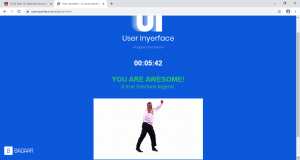
User Inyerfeace Online Game by Bagaar
It was my first time playing User Inyerface and I wasn’t sure what to expect. Once I made it to the second page it was a bit easier to navigate. Perhaps it’s because I know it’s a game so less pressure and I’m familiar with online persuasion architecture ( Zeynep Tufekci). I wasn’t extremely frustrated, but I was still frustrated at parts of the game such as when I had to fill out the email and password portion and all these pop-ups kept appearing again and again. It also took some time to navigate through the buttons that didn’t work and the texts that try to deceive you. I had to re-read these parts a few times. Upon reflection, in the past, I’m going to say I was caught in some of the dark patterns employed such as the hidden costs when your paying for airfare or for a cruise. I’m going to agree with Tristan Harris in his Ted Talk video that a step to change is to acknowledge that we can be persuaded. When Zeynep Tufekci mentioned about googling for boots and suddenly those boots pop up everywhere on my Facebook to articles I read, it’s scary how learning algorithms work.
Using Brignull’s Dark Pattern types, I was trying to categorize some of them in the game. One was the Forced Continuity where it showed the four easy step visual to complete the form, but if you check the terms and agreements that was in small print which was lengthy, confusing and required additional steps to complete. Do I sense a trap here ? This could also be under the Trick Question type also. The Roach Motel in the game was when the pre-select mode for the email gave the illusion that it was trying to help the consumer by making it easier for them to complete the form and I see this a lot in online subscriptions, but it’s always a difficult process to get out of it. The beginning page of the game was under Disguised Ads as I see this on a lot of online articles where in the middle of the article there are usually words that are highlighted, underlined, or capitalize to draw your attention to click on it.
References:
Brignull, H. (2011). Dark Patterns: Deception vs. Honesty in UI Design. Interaction Design, Usability, 338.
Harris, T. (2017). How a handful of tech companies control billions of minds every day. Retrieved from https://www.ted.com/talks/tristan_harris_the_manipulative_tricks_tech_companies_use_to_capture_your_attention?language=en
Tufekci, Z. (2017). We’re building a dystopia just to make people click on ads. Retrieved from https://www.ted.com/talks/zeynep_tufekci_we_re_building_a_dystopia_just_to_make_people_click_on_ads?language=en